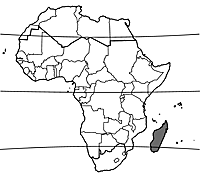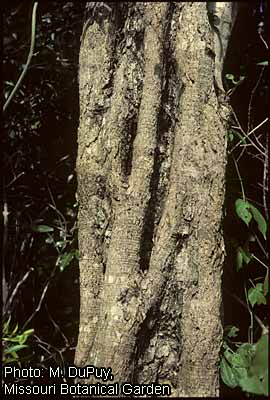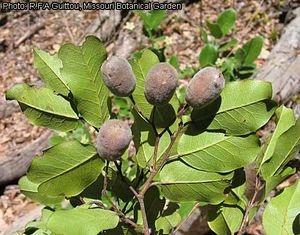Introduction |
Baudouinia fluggeiformis Baill.
- Protologue: Adansonia 8: 201 (1868).
- Family: Caesalpiniaceae (Leguminosae - Caesalpinioideae)
Origin and geographic distribution
Baudouinia fluggeiformis is endemic to Madagascar, where it is quite widespread in the western and central parts of the island.
Uses
The wood is considered valuable, but is generally used for posts and poles in house building, and for cattle enclosures. Leaf decoctions and the gum from the bark are used in traditional medicine to treat pharyngitis and bronchitis.
Properties
The wood is very hard and resilient.
Description
- Deciduous small tree up to 15(–20) m tall; bole fluted, up to 50(–70) cm in diameter; bark surface initially smooth and whitish to pale grey, but becoming brownish and rather rough; twigs usually short-hairy when young, but soon becoming glabrous, with lenticels.
- Leaves alternate, simple and entire; stipules narrowly ovate, 2–3 mm long, caducous; petiole 3–6 mm long, swollen and wrinkled; blade elliptical to obovate, 1–5 cm × 1–4.5 cm, cuneate to obtuse at base, obtuse to notched at apex, thinly leathery, nearly glabrous, pinnately veined with 5–6 pairs of lateral veins.
- Inflorescence an axillary cyme 2–4 cm long, many-flowered.
- Flowers bisexual, regular, 5-merous, yellow, scented; pedicel 5–12 mm long; sepals free, narrowly ovate, 4–9 mm long, slightly hairy; petals free, oblong-elliptical, 5–7 mm long, glabrous; stamens 8–10, filaments 1–2 mm long, anthers 1.5–6 mm long; ovary superior, spindle-shaped, 1.5–4 mm long, with short stipe, densely hairy, style 1.5–3 mm long.
- Fruit a drupe-like, ellipsoid to nearly globose pod 1–2(–2.5) cm long, short-hairy, indehiscent, 1–2(–4)-seeded.
- Seeds oblong-ellipsoid to nearly globose, 5–7 mm long, pale brick red.
Other botanical information
Baudouinia comprises 6 species and is endemic to Madagascar. It belongs to the tribe Cassieae subtribe Dialiinae, and it has been suggested that it is related to the genera Eligmocarpus and Mendoravia from Madagascar and Poeppigia from tropical America.
Baudouinia louvelii
The wood of Baudouinia louvelii R.Vig., an evergreen small tree up to 15 m tall with a limited distribution in the central part of eastern Madagascar, is used for carpentry, flooring and outdoor joinery. The wood is heavy, with a density of about 950 kg/m³ at 12% moisture content, and very hard. It has high shrinkage rates during drying, but is stable in service. It is very resistant to fungi and moderately resistant to termites and dry-wood borers.
Baudouinia rouxevillei
The wood of Baudouinia rouxevillei H.Perrier, a small tree up to 15 m tall restricted to a small area in south-western Madagascar, is much sought after. The bole and branches of this species are deeply folded and channelled, with dark brown wood except for the outermost edges of the folds where it is whitish. This gives a very decorative effect and the wood is in high demand for making ornaments, lamp stands and walking-sticks. It is also used for charcoal production. Baudouinia rouxevillei has become endangered due to over-exploitation, possibly being even close to extinction.
Ecology
Baudouinia fluggeiformis occurs in deciduous forest and woodland, also in dry woodland and scrubland, up to 500(–700) m altitude. It is said to prefer sandy and alluvial soils, but in the dry forest near Morondava it is mainly found on slopes and is more rare on clayey soils in valleys.
Genetic resources
Baudouinia fluggeiformis is widespread in Madagascar in a wide variety of habitats and not endangered by genetic erosion. However, it is locally threatened by selective exploitation, e.g. in Bongolava forest, where it suffers also from uncontrolled burning. Other species of Baudouinia all have very limited areas of distribution where they are more or less confined to a specific habitat, and could easily become endangered.
Prospects
Baudouinia fluggeiformis will remain of local importance for its very hard and probably durable wood that is in demand for posts and poles. It deserves more attention in research because little is known on nearly all aspects. Research on other Baudouinia spp. should focus more on protection than on exploitation.
Major references
- du Puy, D.J., Labat, J.N., Rabevohitra, R., Villiers, J.-F., Bosser, J. & Moat, J., 2002. The Leguminosae of Madagascar. Royal Botanic Gardens, Kew, Richmond, United Kingdom. 750 pp.
- Rakotovao, G., Rabevohitra, R., Gerard, J., Détienne, P. & Collas de Chatelperron, P., en préparation. Atlas des bois de Madagascar. FOFIFA-DRFP, Antananarivo, Madagascar.
- Razafimahaleo, R., 1992. Mpanjakabenitany: fin de règne. Vintsy 4: 14.
Other references
- Boiteau, P., Boiteau, M. & Allorge-Boiteau, L., 1999. Dictionnaire des noms malgaches de végétaux. 4 Volumes + Index des noms scientifiques avec leurs équivalents malgaches. Editions Alzieu, Grenoble, France.
- Lewis, G., Schrire, B., MacKinder, B. & Lock, M., 2005. Legumes of the world. Royal Botanic Gardens, Kew, Richmond, United Kingdom. 577 pp.
- Neuwinger, H.D., 2000. African traditional medicine: a dictionary of plant use and applications. Medpharm Scientific, Stuttgart, Germany. 589 pp.
Author(s)
- R.H.M.J. Lemmens, PROTA Network Office Europe, Wageningen University, P.O. Box 341, 6700 AH Wageningen, Netherlands
Correct citation of this article
Lemmens, R.H.M.J., 2010. Baudouinia fluggeiformis Baill. [Internet] Record from PROTA4U. Lemmens, R.H.M.J., Louppe, D. & Oteng-Amoako, A.A. (Editors). PROTA (Plant Resources of Tropical Africa / Ressources végétales de l’Afrique tropicale), Wageningen, Netherlands. <http://www.prota4u.org/search.asp>.
Accessed 2 June 2025.
- See the Prota4U database.





